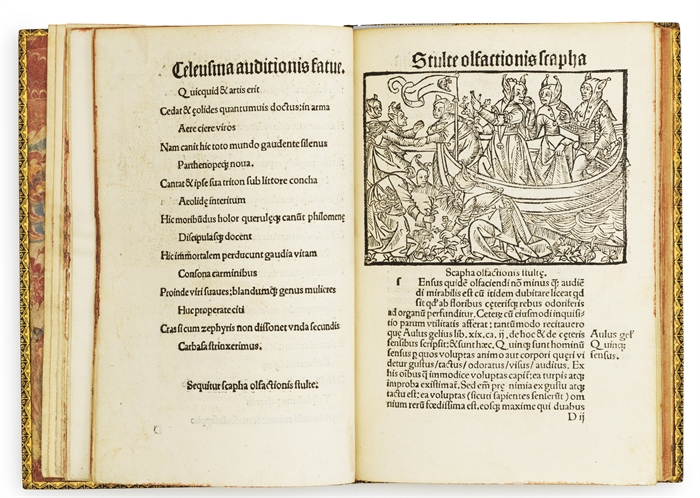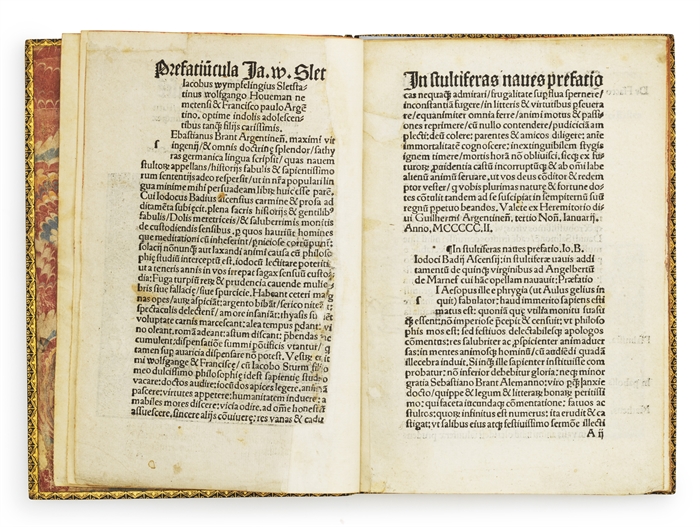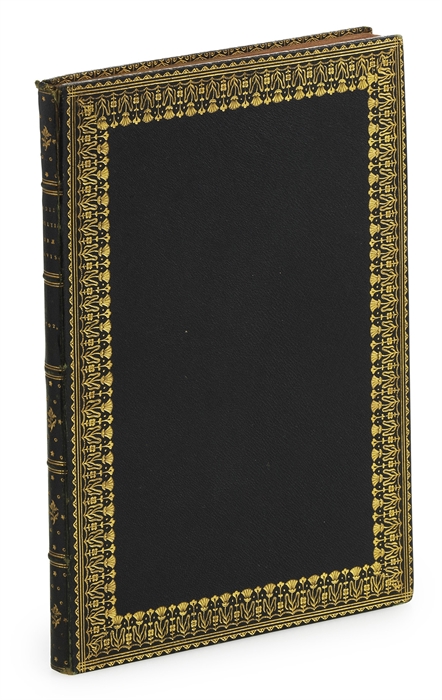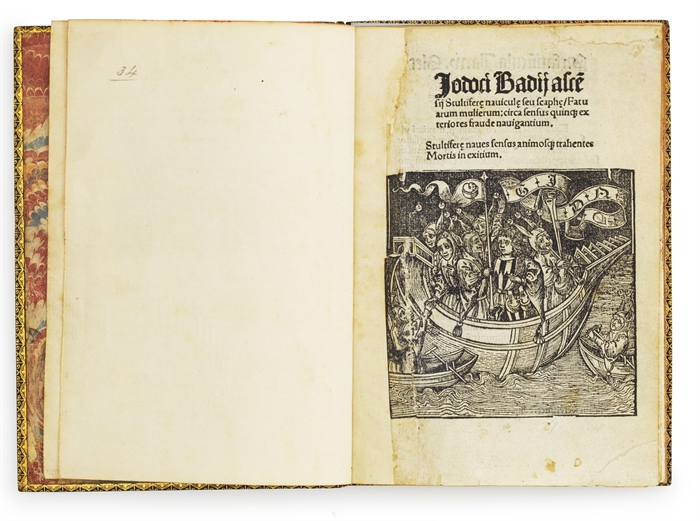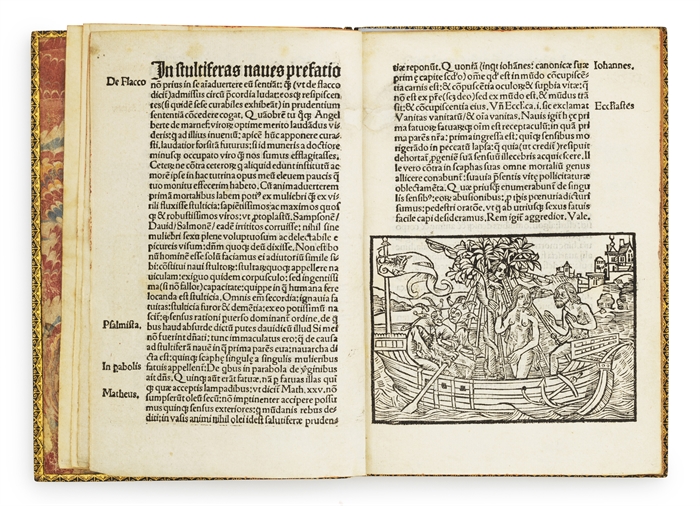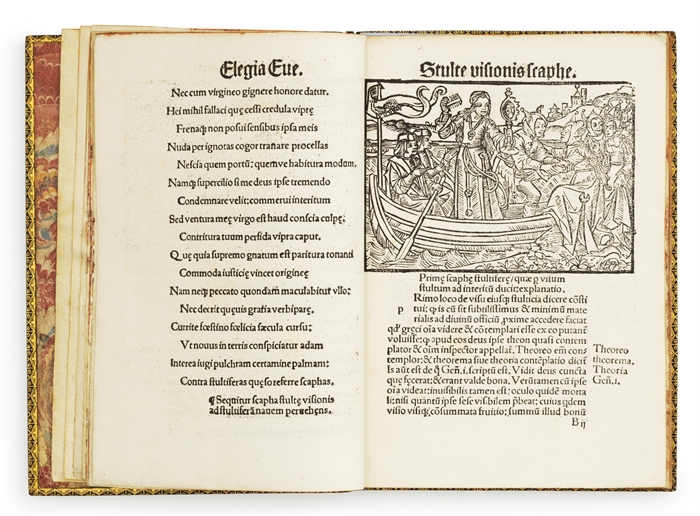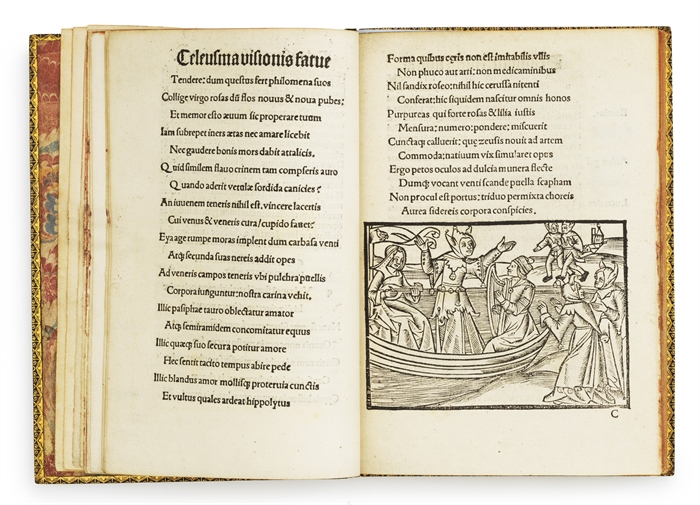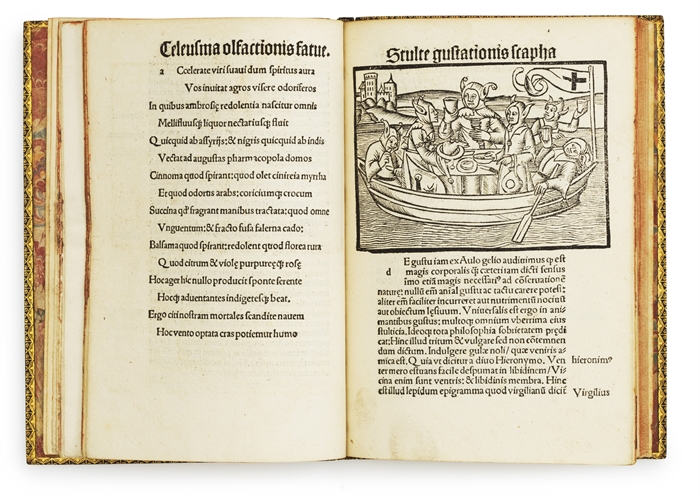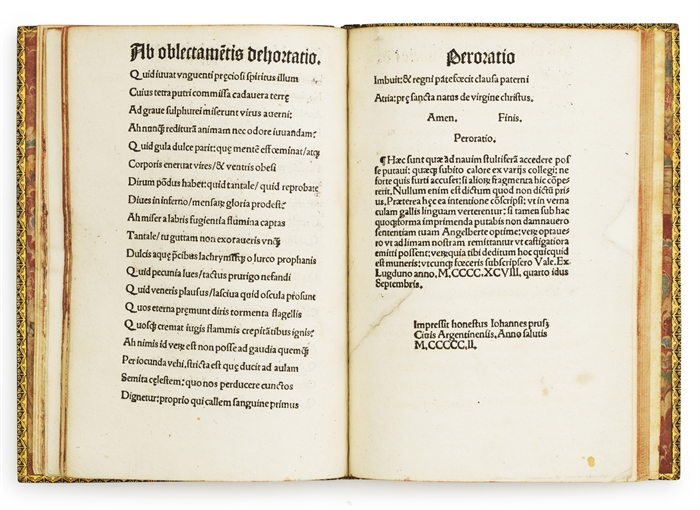"THE SHIP OF FEMALE FOOLS" - THE WARDINGTON-COPY
BADIUS, JODOCUS ASCENSIUS.
Stultiferae naviculae seu scaphe fatuarum multierum: circa sensus quinque exteriors fraude navigantium.
Strassburg, Johann Pruss, 1502.
4to (195 x 137 mm). Bound in a beautiful 19th-century full calf binding with gilt lettering and ornamentation to spine, elaborate gilt borders to boards, inner gilt dentelles, gilt ornamentation to edges of boards. All edges gilt. Ex-libris to both front and back pasted-down end-papers and front and back free end-papers (see below). Title-page reinforced at inner margin and with loss of paper, slightly touching the woodcut illustration. Last leaf with marginal repair and a closed tear. 33 lines to a page. 24 ff. (A4, B6, C-D4, E6). Withbound are 33 blank leaves in the back. A very nice copy. 7 Woodcut illustrations in the text inspired by (but not an adaptation of) Brant's 'Das Narrenschiff'.
Provenance:
John William Beaumont Pease, 1st Baron Wardington (1869–1950)
Christopher Henry Beaumont Pease, 2nd Baron Wardington (1924–2005)
Lucy Anne Paese (1966 - )
Rare second edition - considered more attractive than the first, as it contains a short preface (on the verso of the title) by J. Wimpheling of Schlettstadt – of Badius’ ‘Ship of Female Fools’, a supplementary work to Sebastian Brant’s Ship of Fools, which Badius had translated into Latin. In his address to Marnef, the publisher of the original Latin edition of Brant’s work (1500), Badius explains that this book, ‘Ship of Female Fools’, serves to fill a gap left by Brant - specifically, the omission of satirical chapters on the faults and follies of women. The ship of fools is an allegory, first appearing in Book VI of Plato's Republic, about a ship with a dysfunctional crew. The allegory is intended to represent the problems of governance prevailing in a political system not based on expert knowledge. The Basel humanist Sebastian Brant described in his famous ‘Narrenschiff’ (1494) a sea journey of 112 individuals representing the follies of human weakness and vice to 'Naragonia' the paradise of fools: 'The first original work by a German which passed into world literature, and helped to blaze the trail that leads from medieval allegory to modern satire, drama and novel of character' (PMM). Badius’ work not only extends Brant’s satirical allegory but also reflects the deeply entrenched misogynistic perspectives of the late Medieval and early modern periods. By attributing the origins of folly to women and depicting them as the driving force behind moral corruption, Badius underlines the prevailing theological and humanistic views that saw female nature as inherently dangerous and deceptive. Adams B-24.
The work consists of six chapters written in both Latin verse and prose, accompanied by seven woodcut illustrations (including the one on the title-page) that closely follow the Parisian original. These depict the Ships of Eve and the vessels representing the five senses.
“The Flemish humanist and publisher, Jodocus Badius Ascensius (Josse Bade van Asche), composed an additional text in Latin to Sebastian Brant’s Ship of Fools, in verse and prose addressed to an elite audience, entitled Stultifera navis sensus animosque tractans Mortis in exitium (The Ship of Female Fools and the Five Senses... drawn toward death and ruin). In the preface to his additamentum, Badius notes that he decided to complete the Brantian fleet by adding "a small boat, but with enormous capacity" dedicated to perilous female folly, since, "As I have remarked, the first blemish of mortals came more from the folly of woman than of man."” (Pinson, Led by Eve. The Large Ship of Female Fools and the Five Senses).
”In late medieval and early modern written and visual culture, woman, in the guise of Eve/Venus/Lust, incarnates danger and is conceived as a powerful temptress. The biblical story of the temptation casts the first woman as the deceiver of man, determining his fate. For the Fathers of the Church, Eve, the wicked temptress and devil’s accomplice, became the prototype of the powerful and fatal women whose sexual charms were irresistible to men.
This nexus of ideas, particularly influential in northern humanistic circles, especially among the cultivated urban milieu, was incisively imagined as a train of perilous ships of female fools incarnating the senses by Jodocus Badius toward the end of the fifteenth century, elaborated by Jehan Drouyn to include female fools embodying the vices.
Badius thus made plain his misogyny by regarding the "additional skiff" in the convoy of ships of fools. The small boat of foolish women, now annexed to Brant’s vision, completes the picture of the folly of mankind.” (Pinson Led by Eve. The Large Ship of Female Fools and the Five Senses)
'Ship of Female Fools' serves as both a literary expansion of Narrenschiff and a fine testament documenting the anxieties and gendered biases of its time.
Brunet I, 607.
BM STC German, 1455-1600, p. 62.
Order-nr.: 62020

